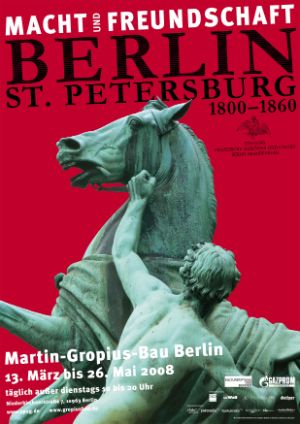Exhibition
Power and Friendship.
Berlin – Saint Petersburg 1800–1860

Poster of the exhibition “Power and Friendship. Berlin–Saint Petersburg 1800–1860” Design: Waldemar Strempler, SPSG
Rediscovering an era of European History
The intensity of German-Russian cultural exchange during the first half of the Nineteenth century is unparalleled. This was defined by both the political constellation in Europe and the close personal relationships binding the Prussian and Russian ruling houses. In this exhibition, these singular relations between Prussia and Russia are highlighted for the first time.
“Power and Friendship. Berlin – St. Petersburg 1800–1860”, to be shown in the Martin-Gropius-Bau in Berlin from 13th March to 26th May 2008, has been a long-term project of the Stiftung Preußische Schlösser und Gärten Berlin-Brandenburg in collaboration with partners such as the State Hermitage Museum St. Petersburg and the Peterhof State Museum-Reserve as well as five further lenders in Russia and numerous national and international lenders.
Moscow has repeatedly been the subject of attention, and now the view turns to the city known since its foundation in 1703 as the “window to Europe”, capital of the Russian Empire from 1712 to 1917.
The relations between Prussia and Russia, characterized in equal measure by political circumspection and intense cultural activity, stand at the centre of the exhibition “Power and Friendship. Berlin-St. Petersburg 1800-1860”. The Napoleonic Wars and the resultant “Holy Alliance” between Russia, Prussia and Austria, the revolutionary events of 1830/31 and 1848 lend these relations a pan-European aspect. In the battle against Napoleon, close personal relationships arose between the allies, Czar Alexander I, King Friedrich Wilhelm III and Queen Luise. The wedding in 1817 of the Russian Grand Prince Nikolai Pawlovitsch, later to become Czar Nikolas I, and the then Princess Charlotte of Prussia, later to become Alexandra Feodorovna and Czaress of Russia following her conversion to the orthodox faith, lent these relationships a more private character defined by affection and sympathy. Both levels, made transparent within the exhibition, defined the cultural climate in Berlin and St. Petersburg.
Particular attention is paid to the lively mutual artistic and cultural exchange involving the architects Wassily Stassow and Karl-Friedrich Schinkel, academics Alexander von Humboldt and Wassily Shukowski, the painters Franz Krüger, Eduard Gaertner and Grigori Tschernetzow and the sculptors Christian Daniel Rauch, Carl Friedrich Wichmann and Baron Peter (Pjotr) Clodt von Jürgensburg. The development of cultural landscapes and collections in Berlin and Potsdam, St. Petersburg and its environs today reveal many parallels: a Russian village, Alexandrowka, and a Russian church were built in Potsdam; Berlin came by its “Alexanderplatz”. Nikolas I, for his part, had the famous Peterhof summer residence designed along the lines of the Potsdam model. The construction of the Roman Baths in Sanssouci rendered the blueprint for the Czar Pavilion, and in Sanssouci and in Peterhof the same sculptures were installed. The most visible symbol of Prussian-German mutuality were the famous “Horse Tamers“ installed on the Anitschkow Bridge in St. Petersburg in 1841; their twins were placed before the Berlin City Palace in 1844.
Visual testimonies on canvas, paper and porcelain as well as requisites of court happenings such as the “Lalla Rookh” festival in Berlin in 1821, the “Festival of the White Rose” in Potsdam in 1829 and the Kalisch Parade in 1835, as well as the travel journals kept by Friedrich Wilhelm IV bring this époque to life; an époque that was politically conservative and yet still affected by harbingers of the modern. The incipient division between “public” and “private” begin here. This is manifest in the contrast between major urban neo-classicist projects on the one hand and the design of the living spaces of both the Czar’s and the Royal family – almost suggestive of the Biedermeier style – on the other. Both will be presented in the exhibition in their own exhibition rooms with architectural plans and depictions of the interiors.
Exhibition Concept
The exhibition parcours emphasizes the interchange between rooms with specific themes and different structures. Sparse rooms devoted to politics contrast with those filled with artworks of various types and which make the flourishing cultural exchange tangible. The selection of the exhibits mirrors the medial predilections of the era.
Organizer: Stiftung Preußische Schlösser und Gärten Berlin-Brandenburg.
Made possible by the Federal Cultural Foundation and the GAZPROM Germania GmbH. Supported by Dussmann AG & Co. KGaA, DKB Stiftung für gesellschaftliches Engagement, Wall AG, Kuhn & Bülow Versicherungsmakler GmbH und Gothaer Versicherungen.
Patronage: Frank-Walter Steinmeier, Federal Foreign Minister
Curators: Jürgen Luh (Berlin), Ada Raev (Berlin)